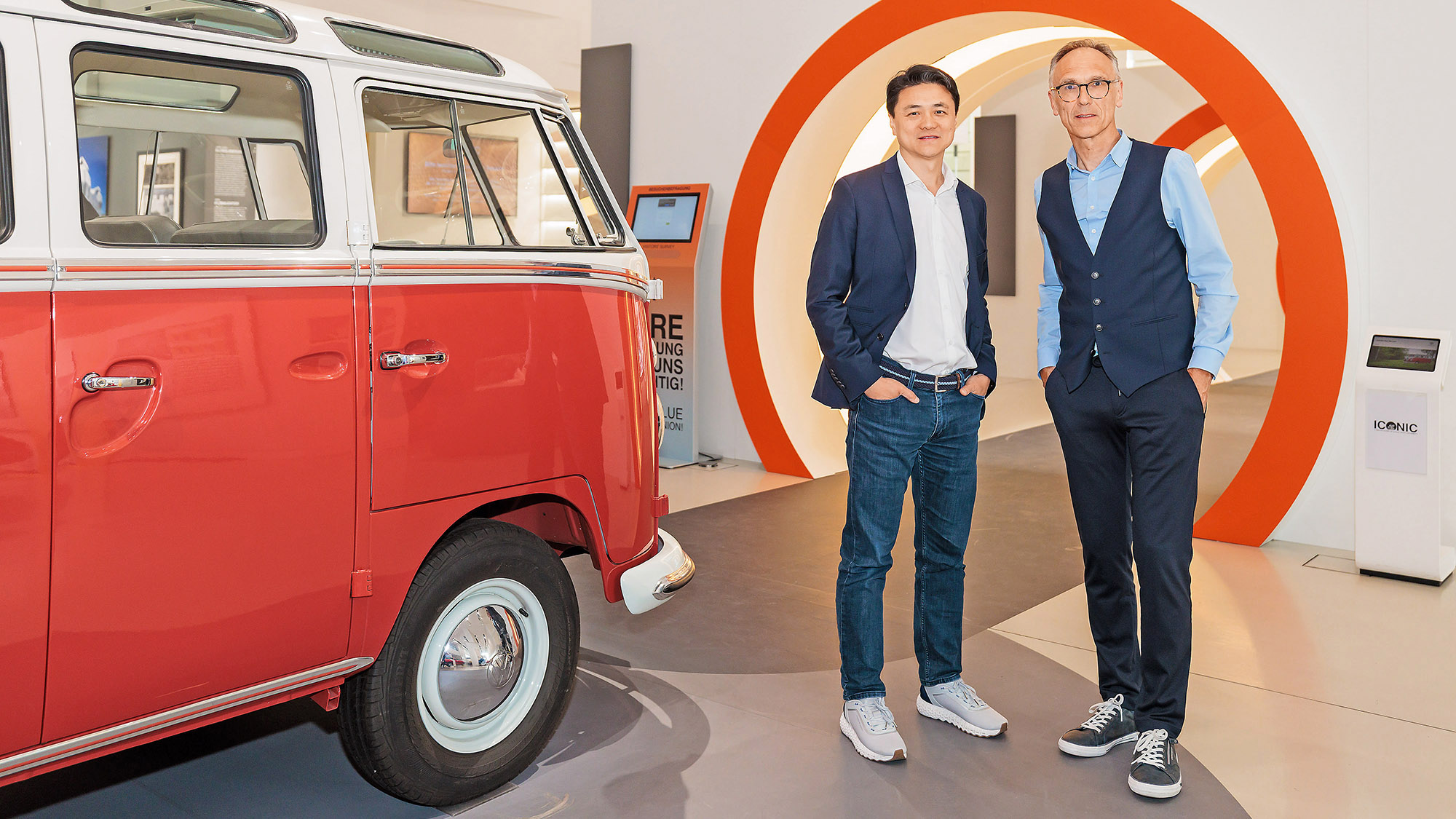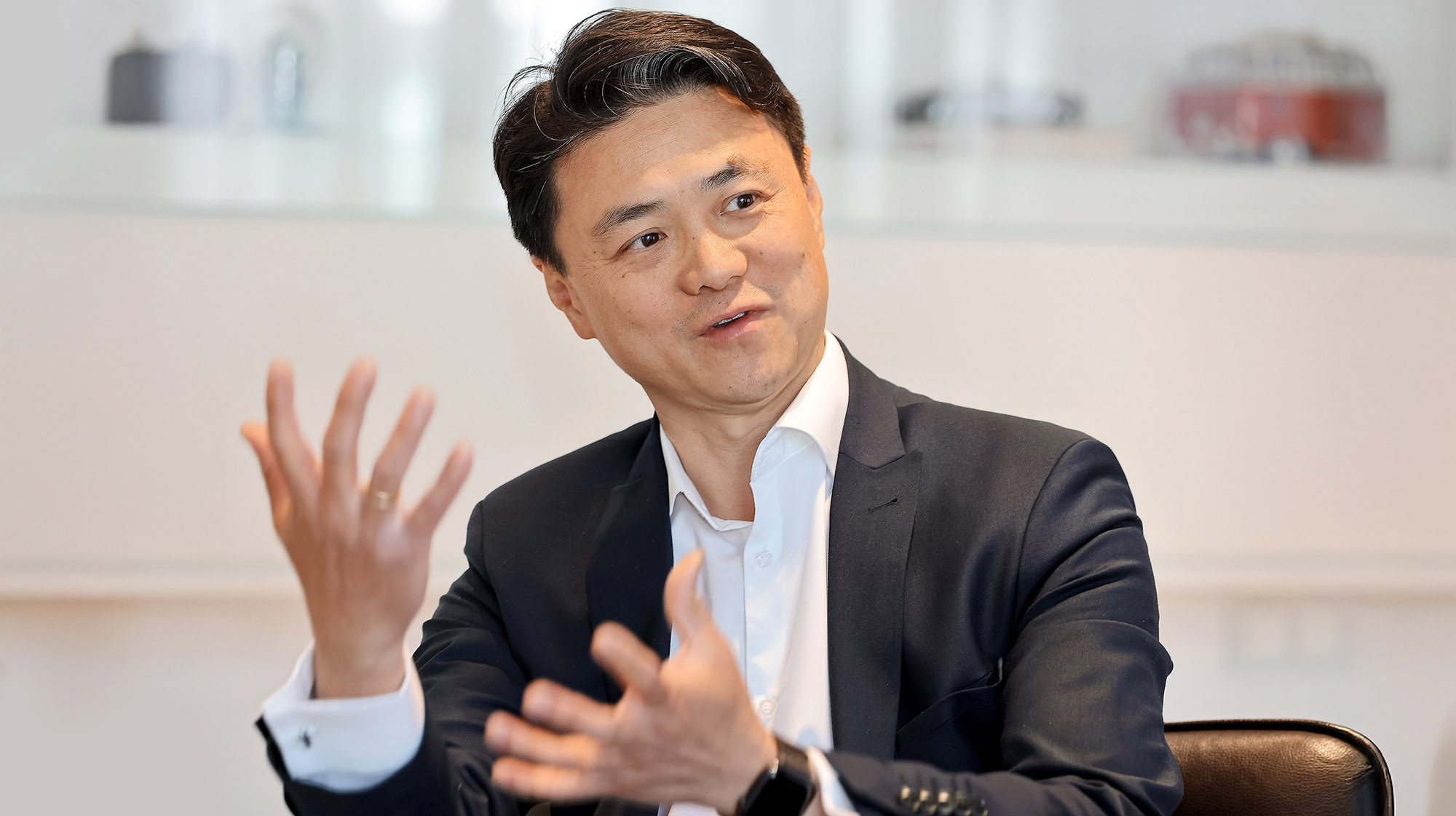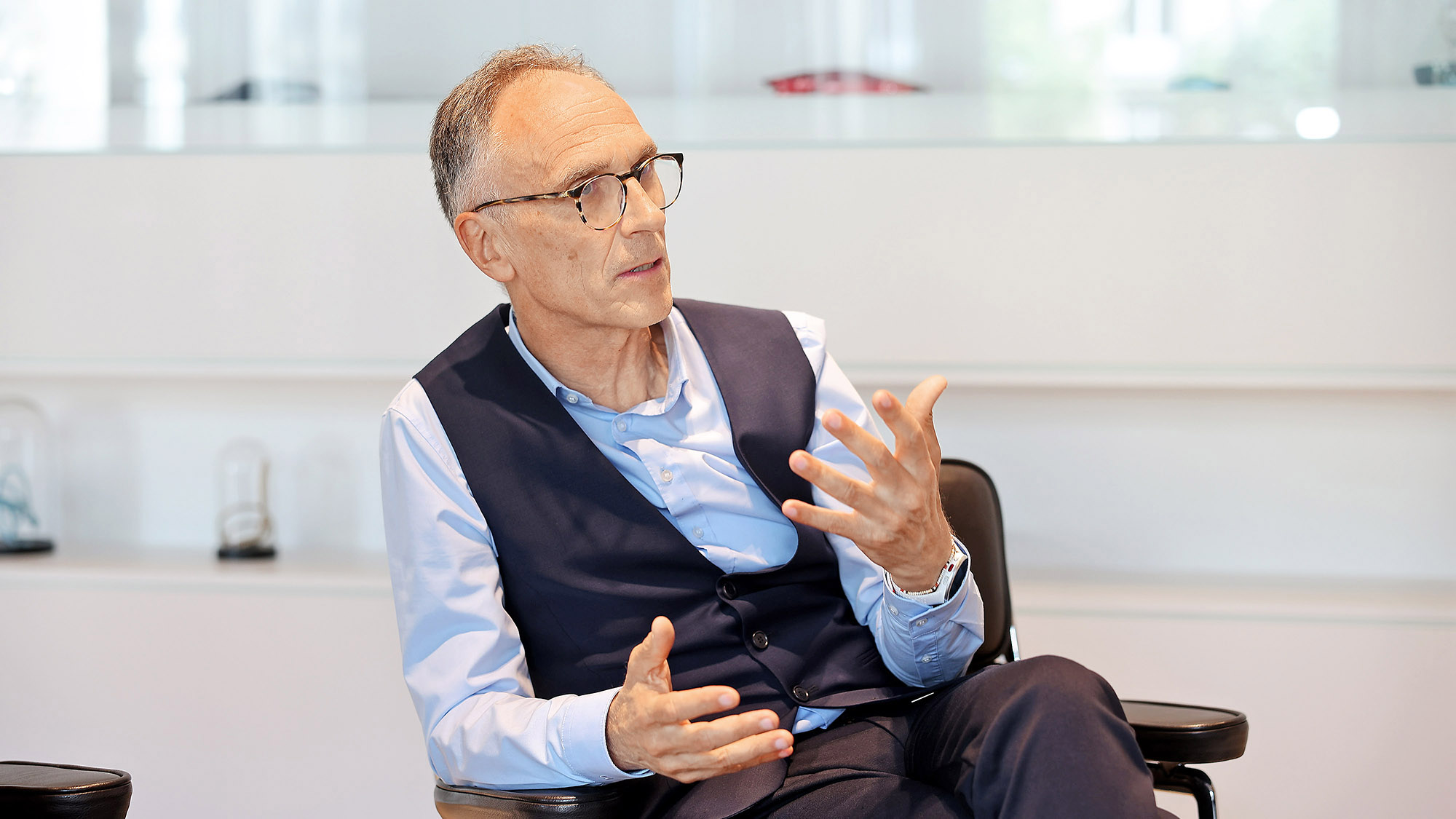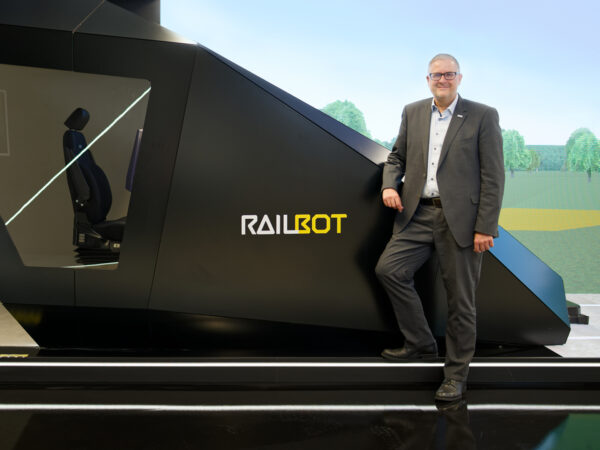“The gap alignment mentality still prevails in Europe”
An interview with the mobility experts Professor Zheng Han and Professor Andreas Herrmann about the ability of the Chinese to adapt and the future of Europe’s automotive industry.
07/2025

Europe’s automotive industry is facing an historic turning point. Electric mobility, digitalization and geopolitical shifts are changing the ground rules. In an interview with Prof. Zheng Han (Tongji University, Shanghai) and Prof. Andreas Herrmann (University of St. Gallen), we discuss how European and Chinese manufacturers are positioning themselves, which role Europe could play in the future – and what the industry should learn from China. One key issue is speed. While European manufacturers focus on perfection, short development cycles and fast market launches dominate the business in China.
Professor Han, how do you view the issue of mobility and Europe from a Chinese perspective?
Prof. Zheng Han: China’s government has singled out mobility as a strategic issue for decades now. This involved defining electric mobility as a key pillar of industry – the strategic work put into this is now bearing fruit, particularly in China’s domestic market. China’s next goal is to achieve international success as well. The European market will play an extremely important role in this. In the current geopolitical situation, the focus is not being directed at the USA. Europe, on the other hand, has an emotional and strategic importance for Chinese manufacturers. It is the birthplace of the automobile – and an established market with high quality standards. For Chinese OEMs, being successful here is a project that brings prestige.
While there is great respect for the inventors of the automobile, does Europe even still have a chance of playing a leading role in the future?
Han: In the past, China always looked up to the West, especially when it came to the automobile. In terms of today’s automotive development, however, it has built up a lot of self-confidence over a short period of time, in part because Chinese manufacturers have succeeded in winning a share of the market from established players. European manufacturers are currently struggling to apply their past formulas for success to the future. However, I think it would be premature to refer to Europe as having been left behind. Chinese manufacturers aren’t finding the framework conditions here that made them successful in their home market either.
Professor Herrmann, what do you think Europe’s chances look like?
Prof. Andreas Herrmann: When it comes to battery technology and autonomous driving, manufacturers in Europe must make a huge effort to ensure they are able to keep pace. The economies of scale that Chinese and American suppliers have already been able to implement are enormous. We have the know-how – but not the critical mass. That’s the technological side of things. However, industrial policy is a further component. In order to keep pace with the tech giants from Silicon Valley, Europe would need a software giant of its own. That’s something we shy away from. Instead, we have a piecemeal landscape consisting of smaller medium-sized companies. Here’s an example: The EU is lending its support to 80 projects with two or three autonomous buses each – instead of two large flagship projects with 500 vehicles. This is a homeopathic approach which is ultimately ineffective. What we really need is the concentration and the focus we are seeing in China and the USA. Industrial policy based on the watering can principle is a major disadvantage for Europe, because in times of disruption, shining lights are needed.
What strengths do you consider European manufacturers to have which Chinese ones might be slower to catch up on?
Herrmann: Chinese manufacturers are still finding branding and marketing difficult. But I’m not sure how long Europeans will be able to maintain their lead. The Chinese learn quickly – and are systematically recruiting European experts to help them. In principle, I have no doubt that they will reach a European level in terms of marketing and sales.
Han: Many Chinese manufacturers encountered significant market challenges when starting out. They underestimated the complexity of European marketing and sales, and customer loyalty. They are, however, extremely capable of learning. By now, they have understood what doesn’t work and are investing heavily in local know-how – including personnel. This ability to change is a factor in their success.

This is a factor that the Europeans, at times, are lacking. Is it a matter of Chinese speed vs. German diligence?
Han: China uses its domestic market as a key testing and learning arena. Innovations are often launched there at an early development stage, with the first optimizations being made based on real experiences of use – before they are rolled out internationally. The Chinese still need a little time to reach a European level in terms of quality, however the clock is ticking for the Europeans.
Herrmann: The gap alignment mentality still prevails in Europe. In China, software and the courage to innovate are key factors – along with a willingness to fix any faults using over-the-air updates. We are not particularly resourceful when it comes to adaptability, which is, of course, due to the fact that this industry has been extremely successful, and has been Europe’s flagship. The automotive industry is now looking back at times past with a certain paralysis and nostalgia, and ultimately can’t find the strength to reinvent itself.
Is Chinese speed even possible outside of China with the same ease? Are compromises in terms of quality and safety conceivable in Europe?
Han: I do actually think that Chinese customers are considerably more open to risks. They still buy tech products even though they haven’t been tested for long. In Europe, consumers are far more risk averse – which is good for European manufacturers, because their strength is quality. However, digitalization is also a key dimension in the automotive sector. In this regard, it’s not only quality that matters, but rather, and above all, a very strong customer service strategy. This customer-oriented product development and the focus on services is something that Chinese companies also do very well, which is where their competitive advantage can be found as long as they are still unable to compete with the established companies in terms of technology and quality. The Germans would do well to learn something from this customer service strategy.
What else could the European automotive industry learn from China?
Herrmann: In addition to development time and a software mentality instead of a focus on gap alignment, it’s also a matter of speed as far as brands are concerned. The major manufacturers could also use the courage to try out new brands. Otherwise, their heritage will eventually become a burden.
Han: Europeans are currently trying to become more Chinese when it comes to design, the human machine interface (HMI) and digital functionalities, for example. They also have to localize in order to be successful in China, while the Chinese, in turn, are also trying to do this in Europe. Designers from Europe were recently recruited to work for Chinese OEMs. These companies are themselves leaders in certain technological fields, such as batteries, and do not require any expertise from Europe. At the same time, they are closely observing the areas in which others exhibit strengths – and systematically recruit top international talent.
Has the train already left the station for the Europeans in terms of certain technologies?
Han: If you look at the decades of support for electric mobility as a whole, China has ultimately invested more in this area than any other nation or region in the world. The logic of its approach is similar to an innovation fund with state support – with the aim of building up a market position in a strategic future field at an early stage.
Herrmann: Of course, you can invest billions in anything, however we are now moving into a world that has completely different economies of scale. In a hardware world, there are hundreds of automotive companies. It has room for many different suppliers, and allows them to be successful with the production of one or two million vehicles. In the software-driven world, two million units are nothing. And we won’t have 400 autonomous driving systems or 400 battery manufacturers either. The mechanisms of the hardware world no longer apply. Instead, it’s a matter of “the winner takes it all.” That’s why we’ve needed a German alliance for a long time now, at least in terms of software.

This is not compatible with European antitrust law.
Herrmann: That may be the case, but then that’s something we need to change.
In which direction is the global automotive market evolving?
Herrmann: In recent decades, the world felt like one big market; however, I believe we are now moving into a different phase of economic policy. Trump has started it with his calls for “fairness.” At its core, he wants to relocate value creation, and I think that will be the dominant paradigm over the next few years. As far as China is concerned, it is important to realize that the Germans were a mass supplier to China in recent decades. This role is now being assumed by local brands, and this means that German manufacturers are being edged out into niche products, such as the premium class. I am convinced that the German manufacturers will manage to find their way, however the dominance that they have enjoyed to date has certainly ended.
Han: For Chinese manufacturers, being successful in Europe is not only a matter of prestige, but also an issue of corporate success. Within China, margins are wafer thin due to this hypercompetition.
Let’s take a look at the future: What will the automotive industry look like in 25 years?
Herrmann: I think the structure as a whole will have shifted in favor of Chinese producers. However, I also believe that there will still be German producers, in a different form. They will all have found their place and their niche. I also believe that markets for internal combustion engines will still exist in certain regions of the world. At the same time, I could well imagine that some cities will no longer allow motorized individual mobility.
Han: The business models will have changed dramatically. What will customers still be willing to pay for? One hypothesis is that digitalization will make the service business more important. However, in the mass market sector, mobility is likely to be more of a commodity. I also suspect that private ownership of cars will decrease and the B2B business will expand instead. It will depend on the location – something that we are already seeing today. When I’m in Shanghai on business, I either use either the subway or ride-hailing services. It really is simple and fast, and saves costs. In Germany, my experience of mobility is a very different one, and I can indulge my passion for the automobile – with an electric vehicle, the Porsche Taycan. I choose to travel short distances by bike.
Herrmann: For me, it also depends on the country. In Switzerland, I use public transport most of the time, because it is sensational. You can rely on it, and that removes a lot of stress from the system. In Germany, I enjoy cruising long distances with my Audi A5 with a diesel engine. Different mobility needs will always exist.
Professor Dr. Zheng Han

Professor Dr. Andreas Herrmann

